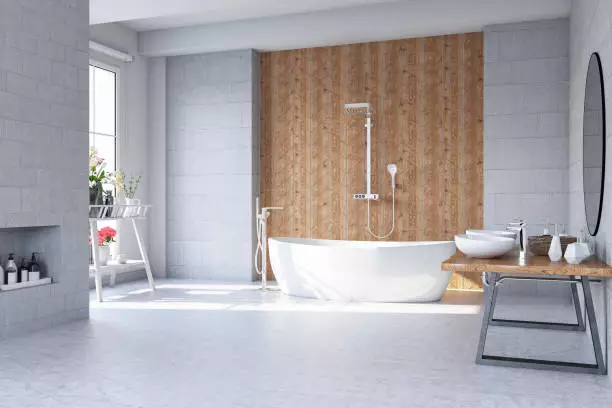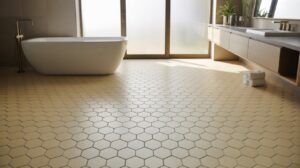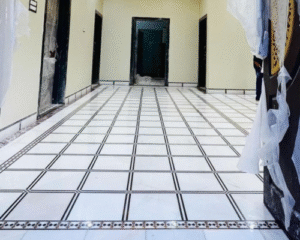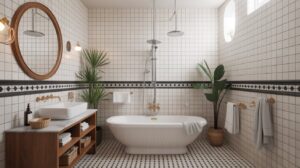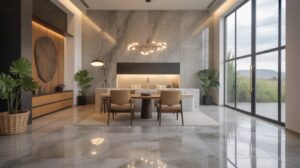A Journey To The Elegance Of A Marble Room
Elegance of A marble room refers to a space or chamber that is entirely constructed or adorned with marble, a type of metamorphic rock known for its beauty and elegance. Marble has been used for centuries in architecture and interior design due to its luxurious appearance and durability. Marble rooms are often associated with opulence, sophistication, and grandeur. The significance of a marble room lies in its aesthetic appeal and the statement it makes about the space it occupies. The use of marble can transform an ordinary room into an extraordinary one, exuding a sense of luxury and refinement. Marble’s natural patterns and unique veining patterns make each piece distinct, adding character and visual interest to the room. Sf Marble and Granite Provides you the best quality and the best guidance you need.
Characteristics Of Elegance Of A Marble Room
A marble room is known for its luxurious and elegant appearance, typically created by the use of high-quality marble as a primary building material.
Table of Contents
TogglePhysical features and components:
Walls and pillars: The walls and pillars of a marble room are constructed using marble slabs or tiles. The marble can be polished to a smooth and glossy finish, enhancing the room’s overall aesthetic appeal. The walls may feature intricate patterns or veining unique to the type of marble used.
Flooring: The flooring of a marble room is also made of marble, which adds a sense of grandeur. Marble flooring can have various finishes, such as polished, honed, or textured, depending on the desired effect. The patterns and colors of the marble can create a visually stunning floor design.
Ceilings: The ceilings in a marble room can be adorned with decorative elements like elaborate moldings, rosettes, or ceiling medallions. These elements are often crafted from marble or other luxurious materials, enhancing the overall opulence of the room.
Decorative elements: Marble rooms often incorporate various decorative elements to accentuate their elegance. These can include marble sculptures, statues, or busts placed strategically throughout the room. Intricate molding and carvings on the walls or pillars can further enhance the room’s visual appeal.
Elegance and luxury associated with marble rooms:
Prestige: Marble has long been associated with wealth, opulence, and prestige. The use of marble in a room instantly creates a sense of luxury and sophistication. Marble rooms are often found in grand mansions, palaces, upscale hotels, and other prestigious establishments.
Timelessness: Marble is a durable material that has been used in architecture and interior design for centuries. The timeless beauty of marble adds a sense of permanence to a room, making it an enduring symbol of elegance and luxury.
Visual appeal: The natural patterns, colors, and veining found in different types of marble contribute to the visual appeal of a marble room. The interplay of light and shadow on the polished surface of the marble creates a captivating effect, adding to the room’s allure.
Reflectivity: Marble has a reflective quality that can make a room appear more spacious and luminous. The polished surface of the marble reflects light, enhancing the overall brightness and creating an inviting ambiance.
Versatility: Marble comes in a wide range of colors, including white, black, beige, green, and more. This versatility allows for various design possibilities, from classic and traditional to modern and contemporary, ensuring that marble rooms can be tailored to different aesthetics while maintaining their luxurious appeal.
Importance of the marble room floor
The marble room floor holds significant importance in interior design due to its elegance, durability, and versatility. Marble has been a popular choice for flooring for centuries and is associated with luxury and sophistication.
Aesthetics: Marble flooring adds a touch of elegance and timeless beauty to any room. The natural patterns and unique veining in marble create a visually stunning effect that can enhance the overall decor and ambiance of a space.
Durability: Marble is a durable and long-lasting material, making it ideal for high-traffic areas. It can withstand heavy foot traffic without losing its charm or deteriorating easily. With proper care and maintenance, a marble floor can last for decades.
Versatility: Marble comes in a wide range of colors, patterns, and finishes, allowing for various design possibilities. Whether you prefer a classic white look or a vibrant colored marble, there are options to suit different interior styles and preferences.
Cooling Properties: Marble has natural cooling properties, making it an excellent choice for warm climates. Walking on a marble floor can provide a refreshing and comfortable feel underfoot.
Types of marble flooring commonly used
Classic white marble: White marble, such as Carrara or Calacatta, is a timeless choice for flooring. It features a clean and elegant look with a white or off-white base color and gray veining. Classic white marble is commonly used in bathrooms, kitchens, and living areas to create a luxurious and sophisticated atmosphere.
Colored marble options: In addition to white, marble is available in a range of colors, including black, green, red, beige, and more. These colored marbles offer unique and striking aesthetics, allowing for creative and personalized flooring designs. Colored marble can be used to make a bold statement or complement specific color schemes within a room.
Varieties of marble patterns and veining: Marble exhibits a wide variety of patterns and veining, adding character and visual interest to the flooring. Some popular patterns include:
Veined marble: This type of marble showcases distinct veining patterns that can be dramatic or subtle, depending on the variety. Examples include Breccia, Emperador, and Portoro marbles.
Cloudy or mottled marble: These marbles feature cloud-like patterns or mottling, creating a unique and artistic effect. Bardiglio and Calacatta Vagli marbles are well-known examples.
Geometric patterns: Marble can be cut and arranged in geometric shapes like chevron, herringbone, or basketweave patterns, adding a touch of sophistication and visual appeal to the flooring.
Random patterns: Some marble varieties have a more random or organic pattern, which can create a natural and organic look. These marbles often have a mix of colors and veining, such as Emperador Dark or Rosa Verona.
Designing a Marble Room
Designing a marble room requires careful consideration of various factors to create a visually appealing and functional space. Here are some key factors to consider in marble room design:
Lighting and Ambiance
Natural light: Marble surfaces often reflect light, so consider the room’s orientation and the amount of natural light it receives. Maximize the use of windows or skylights to enhance the marble’s beauty.
Artificial lighting: Install a combination of ambient, task, and accent lighting to create the desired ambiance. Consider using warm-toned bulbs to bring out the natural colors and veining of the marble.
Color Palette and Material Combinations
Marble selection: Choose the type of marble that best suits your design aesthetic and desired color palette. Consider various options like Carrara, Calacatta, or Emperador marble, each with its unique characteristics.
Complementary materials: Select complementary materials that work well with marble. For example, wood, glass, or metals can create a striking contrast and add depth to the design. Ensure that the materials chosen harmonize with the overall color scheme.
Furniture and Decor Selection
Balance and proportion: Select furniture and decor pieces that are appropriately sized for the room. Ensure they maintain a harmonious balance with the grandeur of the marble. Consider using furniture with clean lines and simple designs to let the marble take center stage.
Textiles and soft furnishings: Incorporate textiles such as curtains, rugs, and upholstery to soften the space and add warmth. Choose materials that complement the marble and enhance the overall aesthetic.
Decorative elements: Use carefully curated decorative elements like artwork, sculptures, or vases to add personality to the room. Consider their scale, color, and texture to create visual interest while maintaining a cohesive design.
Transforming Your Space with Timeless Beauty
Step into a world where every footstep whispers luxury, welcome to the elegance of a marble room. Imagine smooth, polished surfaces reflecting soft light across a space adorned in subtle veins of ivory, gray, and gold. This refined aesthetic not only elevates your home’s style but also provides lasting durability underfoot. When you choose our Marble Floor Installation in Lowell, you’re investing in craftsmanship that marries practical strength with unmatched visual appeal, ensuring your room feels both grand and inviting at every turn.
Conclusion
In conclusion, the allure and elegance of marble rooms are undeniable. The beauty and sophistication that marble brings to any space have made it a timeless choice in architecture and design. The rich history and symbolism associated with marble further enhance its allure, evoking a sense of luxury, prestige, and grandeur.
Marble rooms create a captivating visual impact with their smooth surfaces, intricate veining patterns, and a wide range of colors and finishes. The play of light on the polished marble surfaces adds to their charm, creating a sense of brightness and spaciousness in the room. Feel free to contact us for any query or guidance.
FAQs
What makes a marble room so elegant?
Marble’s unique veining and natural luminosity create a sophisticated backdrop that feels both opulent and timeless. Its reflective quality also brightens spaces, making them appear larger and more welcoming.
How long does professional marble flooring last?
With proper care, using pH-neutral cleaners and prompt spill cleanup marble floors can maintain their beauty and strength for decades, even in high-traffic areas.
Can marble flooring work in any room?
Absolutely. From living rooms and kitchens to grand entryways and bathrooms, marble adapts beautifully to both classic and contemporary designs, seamlessly blending with various materials and color palettes.

